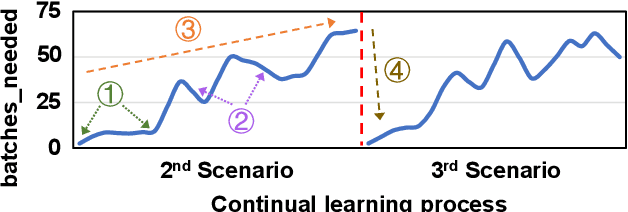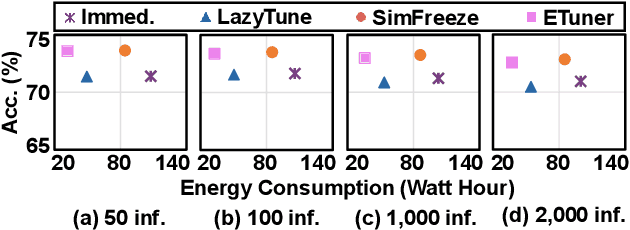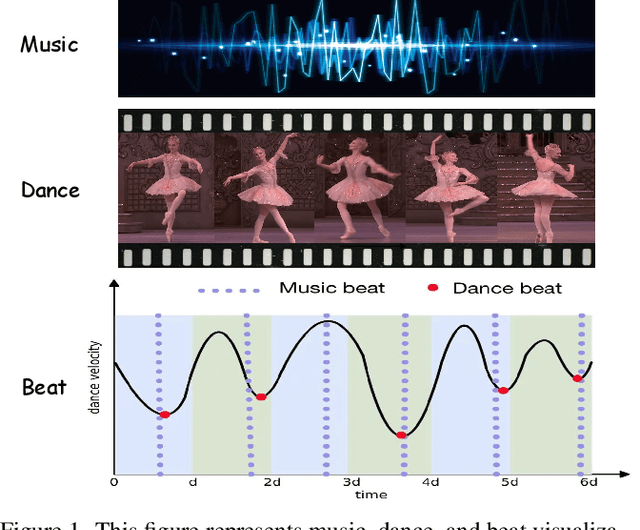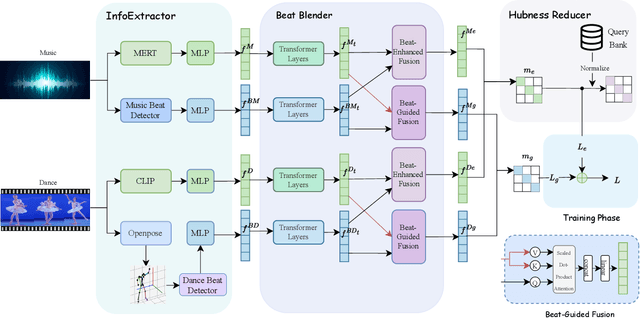Xulong Tang
University of Pittsburgh
CoheDancers: Enhancing Interactive Group Dance Generation through Music-Driven Coherence Decomposition
Dec 26, 2024



Abstract:Dance generation is crucial and challenging, particularly in domains like dance performance and virtual gaming. In the current body of literature, most methodologies focus on Solo Music2Dance. While there are efforts directed towards Group Music2Dance, these often suffer from a lack of coherence, resulting in aesthetically poor dance performances. Thus, we introduce CoheDancers, a novel framework for Music-Driven Interactive Group Dance Generation. CoheDancers aims to enhance group dance generation coherence by decomposing it into three key aspects: synchronization, naturalness, and fluidity. Correspondingly, we develop a Cycle Consistency based Dance Synchronization strategy to foster music-dance correspondences, an Auto-Regressive-based Exposure Bias Correction strategy to enhance the fluidity of the generated dances, and an Adversarial Training Strategy to augment the naturalness of the group dance output. Collectively, these strategies enable CohdeDancers to produce highly coherent group dances with superior quality. Furthermore, to establish better benchmarks for Group Music2Dance, we construct the most diverse and comprehensive open-source dataset to date, I-Dancers, featuring rich dancer interactions, and create comprehensive evaluation metrics. Experimental evaluations on I-Dancers and other extant datasets substantiate that CoheDancers achieves unprecedented state-of-the-art performance. Code will be released.
The Stabilizer Bootstrap of Quantum Machine Learning with up to 10000 qubits
Dec 16, 2024Abstract:Quantum machine learning is considered one of the flagship applications of quantum computers, where variational quantum circuits could be the leading paradigm both in the near-term quantum devices and the early fault-tolerant quantum computers. However, it is not clear how to identify the regime of quantum advantages from these circuits, and there is no explicit theory to guide the practical design of variational ansatze to achieve better performance. We address these challenges with the stabilizer bootstrap, a method that uses stabilizer-based techniques to optimize quantum neural networks before their quantum execution, together with theoretical proofs and high-performance computing with 10000 qubits or random datasets up to 1000 data. We find that, in a general setup of variational ansatze, the possibility of improvements from the stabilizer bootstrap depends on the structure of the observables and the size of the datasets. The results reveal that configurations exhibit two distinct behaviors: some maintain a constant probability of circuit improvement, while others show an exponential decay in improvement probability as qubit numbers increase. These patterns are termed strong stabilizer enhancement and weak stabilizer enhancement, respectively, with most situations falling in between. Our work seamlessly bridges techniques from fault-tolerant quantum computing with applications of variational quantum algorithms. Not only does it offer practical insights for designing variational circuits tailored to large-scale machine learning challenges, but it also maps out a clear trajectory for defining the boundaries of feasible and practical quantum advantages.
SmartFRZ: An Efficient Training Framework using Attention-Based Layer Freezing
Jan 30, 2024



Abstract:There has been a proliferation of artificial intelligence applications, where model training is key to promising high-quality services for these applications. However, the model training process is both time-intensive and energy-intensive, inevitably affecting the user's demand for application efficiency. Layer freezing, an efficient model training technique, has been proposed to improve training efficiency. Although existing layer freezing methods demonstrate the great potential to reduce model training costs, they still remain shortcomings such as lacking generalizability and compromised accuracy. For instance, existing layer freezing methods either require the freeze configurations to be manually defined before training, which does not apply to different networks, or use heuristic freezing criteria that is hard to guarantee decent accuracy in different scenarios. Therefore, there lacks a generic and smart layer freezing method that can automatically perform ``in-situation'' layer freezing for different networks during training processes. To this end, we propose a generic and efficient training framework (SmartFRZ). The core proposed technique in SmartFRZ is attention-guided layer freezing, which can automatically select the appropriate layers to freeze without compromising accuracy. Experimental results show that SmartFRZ effectively reduces the amount of computation in training and achieves significant training acceleration, and outperforms the state-of-the-art layer freezing approaches.
EdgeOL: Efficient in-situ Online Learning on Edge Devices
Jan 30, 2024



Abstract:Emerging applications, such as robot-assisted eldercare and object recognition, generally employ deep learning neural networks (DNNs) models and naturally require: i) handling streaming-in inference requests and ii) adapting to possible deployment scenario changes. Online model fine-tuning is widely adopted to satisfy these needs. However, fine-tuning involves significant energy consumption, making it challenging to deploy on edge devices. In this paper, we propose EdgeOL, an edge online learning framework that optimizes inference accuracy, fine-tuning execution time, and energy efficiency through both inter-tuning and intra-tuning optimizations. Experimental results show that, on average, EdgeOL reduces overall fine-tuning execution time by 82%, energy consumption by 74%, and improves average inference accuracy by 1.70% over the immediate online learning strategy.
BeatDance: A Beat-Based Model-Agnostic Contrastive Learning Framework for Music-Dance Retrieval
Oct 16, 2023



Abstract:Dance and music are closely related forms of expression, with mutual retrieval between dance videos and music being a fundamental task in various fields like education, art, and sports. However, existing methods often suffer from unnatural generation effects or fail to fully explore the correlation between music and dance. To overcome these challenges, we propose BeatDance, a novel beat-based model-agnostic contrastive learning framework. BeatDance incorporates a Beat-Aware Music-Dance InfoExtractor, a Trans-Temporal Beat Blender, and a Beat-Enhanced Hubness Reducer to improve dance-music retrieval performance by utilizing the alignment between music beats and dance movements. We also introduce the Music-Dance (MD) dataset, a large-scale collection of over 10,000 music-dance video pairs for training and testing. Experimental results on the MD dataset demonstrate the superiority of our method over existing baselines, achieving state-of-the-art performance. The code and dataset will be made public available upon acceptance.
SupeRBNN: Randomized Binary Neural Network Using Adiabatic Superconductor Josephson Devices
Sep 21, 2023Abstract:Adiabatic Quantum-Flux-Parametron (AQFP) is a superconducting logic with extremely high energy efficiency. By employing the distinct polarity of current to denote logic `0' and `1', AQFP devices serve as excellent carriers for binary neural network (BNN) computations. Although recent research has made initial strides toward developing an AQFP-based BNN accelerator, several critical challenges remain, preventing the design from being a comprehensive solution. In this paper, we propose SupeRBNN, an AQFP-based randomized BNN acceleration framework that leverages software-hardware co-optimization to eventually make the AQFP devices a feasible solution for BNN acceleration. Specifically, we investigate the randomized behavior of the AQFP devices and analyze the impact of crossbar size on current attenuation, subsequently formulating the current amplitude into the values suitable for use in BNN computation. To tackle the accumulation problem and improve overall hardware performance, we propose a stochastic computing-based accumulation module and a clocking scheme adjustment-based circuit optimization method. We validate our SupeRBNN framework across various datasets and network architectures, comparing it with implementations based on different technologies, including CMOS, ReRAM, and superconducting RSFQ/ERSFQ. Experimental results demonstrate that our design achieves an energy efficiency of approximately 7.8x10^4 times higher than that of the ReRAM-based BNN framework while maintaining a similar level of model accuracy. Furthermore, when compared with superconductor-based counterparts, our framework demonstrates at least two orders of magnitude higher energy efficiency.
Layer Freezing & Data Sieving: Missing Pieces of a Generic Framework for Sparse Training
Sep 22, 2022



Abstract:Recently, sparse training has emerged as a promising paradigm for efficient deep learning on edge devices. The current research mainly devotes efforts to reducing training costs by further increasing model sparsity. However, increasing sparsity is not always ideal since it will inevitably introduce severe accuracy degradation at an extremely high sparsity level. This paper intends to explore other possible directions to effectively and efficiently reduce sparse training costs while preserving accuracy. To this end, we investigate two techniques, namely, layer freezing and data sieving. First, the layer freezing approach has shown its success in dense model training and fine-tuning, yet it has never been adopted in the sparse training domain. Nevertheless, the unique characteristics of sparse training may hinder the incorporation of layer freezing techniques. Therefore, we analyze the feasibility and potentiality of using the layer freezing technique in sparse training and find it has the potential to save considerable training costs. Second, we propose a data sieving method for dataset-efficient training, which further reduces training costs by ensuring only a partial dataset is used throughout the entire training process. We show that both techniques can be well incorporated into the sparse training algorithm to form a generic framework, which we dub SpFDE. Our extensive experiments demonstrate that SpFDE can significantly reduce training costs while preserving accuracy from three dimensions: weight sparsity, layer freezing, and dataset sieving.
Sustainable AI Processing at the Edge
Jul 04, 2022



Abstract:Edge computing is a popular target for accelerating machine learning algorithms supporting mobile devices without requiring the communication latencies to handle them in the cloud. Edge deployments of machine learning primarily consider traditional concerns such as SWaP constraints (Size, Weight, and Power) for their installations. However, such metrics are not entirely sufficient to consider environmental impacts from computing given the significant contributions from embodied energy and carbon. In this paper we explore the tradeoffs of convolutional neural network acceleration engines for both inference and on-line training. In particular, we explore the use of processing-in-memory (PIM) approaches, mobile GPU accelerators, and recently released FPGAs, and compare them with novel Racetrack memory PIM. Replacing PIM-enabled DDR3 with Racetrack memory PIM can recover its embodied energy as quickly as 1 year. For high activity ratios, mobile GPUs can be more sustainable but have higher embodied energy to overcome compared to PIM-enabled Racetrack memory.
A Survey of Large-Scale Deep Learning Serving System Optimization: Challenges and Opportunities
Nov 28, 2021



Abstract:Deep Learning (DL) models have achieved superior performance in many application domains, including vision, language, medical, commercial ads, entertainment, etc. With the fast development, both DL applications and the underlying serving hardware have demonstrated strong scaling trends, i.e., Model Scaling and Compute Scaling, for example, the recent pre-trained model with hundreds of billions of parameters with ~TB level memory consumption, as well as the newest GPU accelerators providing hundreds of TFLOPS. With both scaling trends, new problems and challenges emerge in DL inference serving systems, which gradually trends towards Large-scale Deep learning Serving systems (LDS). This survey aims to summarize and categorize the emerging challenges and optimization opportunities for large-scale deep learning serving systems. By providing a novel taxonomy, summarizing the computing paradigms, and elaborating the recent technique advances, we hope that this survey could shed light on new optimization perspectives and motivate novel works in large-scale deep learning system optimization.
Automatic Mapping of the Best-Suited DNN Pruning Schemes for Real-Time Mobile Acceleration
Nov 22, 2021



Abstract:Weight pruning is an effective model compression technique to tackle the challenges of achieving real-time deep neural network (DNN) inference on mobile devices. However, prior pruning schemes have limited application scenarios due to accuracy degradation, difficulty in leveraging hardware acceleration, and/or restriction on certain types of DNN layers. In this paper, we propose a general, fine-grained structured pruning scheme and corresponding compiler optimizations that are applicable to any type of DNN layer while achieving high accuracy and hardware inference performance. With the flexibility of applying different pruning schemes to different layers enabled by our compiler optimizations, we further probe into the new problem of determining the best-suited pruning scheme considering the different acceleration and accuracy performance of various pruning schemes. Two pruning scheme mapping methods, one is search-based and the other is rule-based, are proposed to automatically derive the best-suited pruning regularity and block size for each layer of any given DNN. Experimental results demonstrate that our pruning scheme mapping methods, together with the general fine-grained structured pruning scheme, outperform the state-of-the-art DNN optimization framework with up to 2.48$\times$ and 1.73$\times$ DNN inference acceleration on CIFAR-10 and ImageNet dataset without accuracy loss.
 Add to Chrome
Add to Chrome Add to Firefox
Add to Firefox Add to Edge
Add to Edge